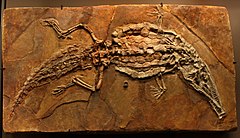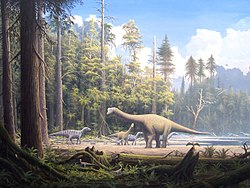
The Solnhofen Limestone or Solnhofen Plattenkalk, formally known as the Altmühltal Formation, is a Jurassic Konservat-Lagerstätte that preserves a rare assemblage of fossilized organisms, including highly detailed imprints of soft bodied organisms such as sea jellies. The most familiar fossils of the Solnhofen Plattenkalk include the early feathered theropod dinosaur Archaeopteryx preserved in such detail that they are among the most famous and most beautiful fossils in the world. The Solnhofen beds lie in the German state of Bavaria (Bayern), halfway between Nuremberg (Nürnberg) and Munich (München) and were originally quarried as a source of lithographic limestone. The Jura Museum situated in Eichstätt, Germany has an extensive exhibit of Jurassic fossils from the quarries of Solnhofen and surroundings, including marine reptiles, pterosaurs, and one specimen of the early bird Archaeopteryx.

Compsognathus is a genus of small, bipedal, carnivorous theropod dinosaur. Members of its single species Compsognathus longipes could grow to around the size of a chicken. They lived about 150 million years ago, during the Tithonian age of the late Jurassic period, in what is now Europe. Paleontologists have found two well-preserved fossils, one in Germany in the 1850s and the second in France more than a century later. Today, C. longipes is the only recognized species, although the larger specimen discovered in France in the 1970s was once thought to belong to a separate species and named C. corallestris.
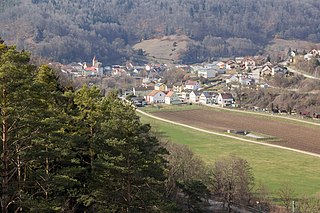
Solnhofen is a municipality in the district of Weißenburg-Gunzenhausen in the region of Middle Franconia in the Land of Bavaria in Germany. It is in the Altmühl valley.

Pleurosaurus is an extinct genus of aquatic reptiles belonging to the order Rhynchocephalia. Pleurosaurus fossils have primarily been discovered in the Solnhofen Limestone of Bavaria, Germany and the Canjuers lagerstatte near Canjuers, France, both dating to the Late Jurassic. It contains two species, P. goldfussi and P. ginsburgi.

Trachyteuthis is a genus of fossil cephalopod, comprising five species: T. hastiformis, T. latipinnis, T. nusplingensis, T. teudopsiformis, T. covacevichi and T. chilensis.
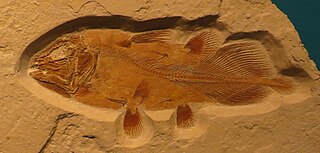
Libys is a genus of coelacanth fish in the family of Latimeridae. Species of Libys lived during the Upper Jurassic period.

Alligatorellus is an extinct genus of atoposaurid crocodyliform found in France that was related to Atoposaurus.
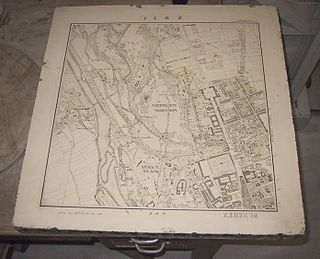
Lithographic limestone is hard limestone that is sufficiently fine-grained, homogeneous and defect free to be used for lithography.
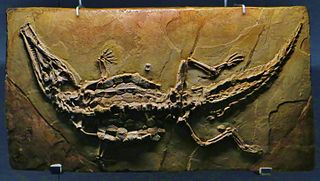
Crocodilaemus is an extinct genus of pholidosaurid mesoeucrocodylian. Fossils have been found from the Cerin Lagerstätte of eastern France and are of late Kimmeridgian age. The depositional environment in Cerin at the time is thought to have been the bottom of a lagoon that was enclosed by an emergent reef complex, evidence of the shallow tropical sea that covered much of western Europe during the Jurassic period.
Ankylophorus is an extinct genus of stem-teleost ray-finned fish that lived in what is now France during the Late Jurassic. Its type and only species, Ankylophorus similis, was originally named in 1895 as a species of Pholidophorus, but was moved to a separate genus in 1978.

Montsecosuchus is an extinct genus of atoposaurid crocodylomorphs. It is the replacement generic name for Alligatorium depereti, which was described in 1915 from the Montsec Lithographic Limestone quarry of Spain. Fossils found from this locality are from the Early Cretaceous, being Upper Berriasian-Lower Valanginian in age, belonging to the La Pedrera de Rúbies Formation While many publications concerning atoposaurids after 1915 have included mentions of A. depereti, none has offered a redescription or revision of the species, though some recognized that great differences existed between it and other members of the genus. In these publications, the skull of A. depereti was shorter in relation to body length than any other species of Alligatorium, and this may have been evidence for the genetic distinction of the species, although no replacement name was proposed. However, better preparation of the holotype specimen MGB 512, a nearly complete articulated skeleton embedded in a limestone matrix now housed in the Museu de Ciències Naturals de Barcelona, allowed for a revision of the species in 1990 in which the name Montsecosuchus was first used.

The Solnhofen Plattenkalk, a collective term of multiple Late Jurassic lithographic limestones in southeastern Germany, is famous for its well preserved fossil flora and fauna dating to the late Jurassic.
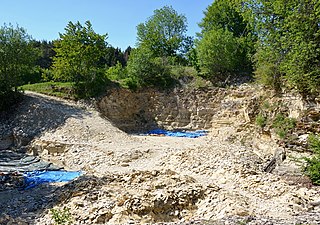
The Nusplingen Limestone is a geological formation in Baden-Württemberg, Germany. It preserves fossils dating to the Kimmeridgian age of the Late Jurassic. It mainly consists of lithographic limestones deposited in a marine basin, similar to the Solnhofen Limestone. Fossils of pterosaurs, thalattosuchians, and the oldest geophilomorph centipede Eogeophilus were found in the Nusplingen Limestone.
The Painten Formation is a geologic formation in Germany. It preserves fossils dating back to the Tithonian stage of the Late Jurassic period.
Victor Joseph de l'Isle Thiollière was a French civil engineer, geologist and paleoichthyologist.

Claude Alexandre Albert Falsan was a French geologist and glaciologist.
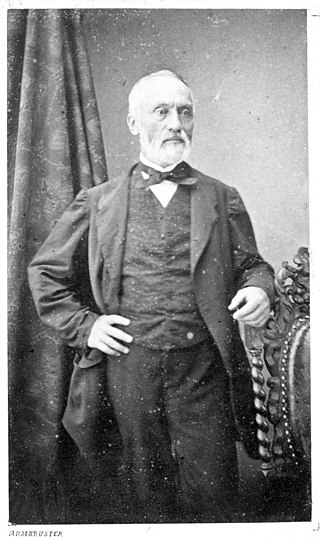
Eugène Dumortier was a French paleontologist.
La Grive-Saint-Alban is a geomorphological karstic site located on the territory of the French commune of Saint-Alban-de-Roche, in the Isère department. This area, long exploited for its red clay, is known since the 19th century for the richness of its fossil deposits, distributed from the Bathonian stage to the Miocene.
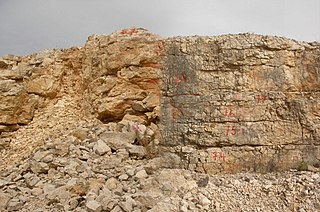
The Canjuers Lagerstätte is a Konservat-Lagerstätte located inside the military camp of Canjuers, in Haute Provence, in the Var department in South-East France.

Pseudastacus is an extinct genus of decapod crustaceans that lived during the Jurassic period in Europe, and possibly the Cretaceous period in Lebanon. Many species have been assigned to it, though the placement of some species remains uncertain and others have been reassigned to different genera. Fossils attributable to this genus were first described by Georg zu Münster in 1839 under the name Bolina pustulosa, but the generic name was changed in 1861 after Albert Oppel noted that it was preoccupied. The genus has been placed into different families by numerous authors, historically being assigned to Nephropidae or Protastacidae. Currently, it is believed to be a member of Stenochiridae.
